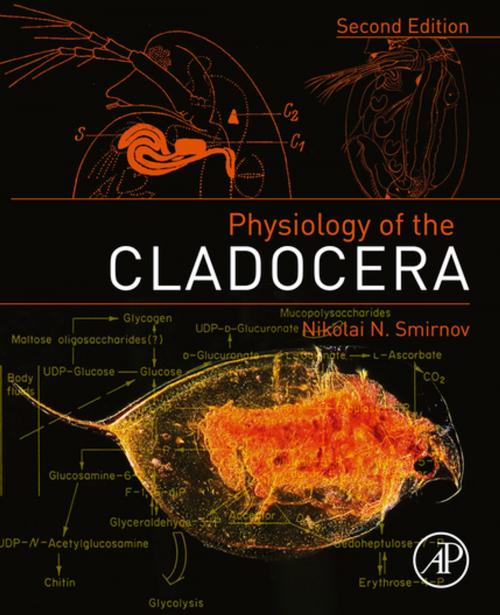Physiology of the Cladocera
Nonfiction, Science & Nature, Science, Biological Sciences, Ecology, Zoology| Author: | Nikolai N. Smirnov | ISBN: | 9780128052815 |
| Publisher: | Elsevier Science | Publication: | June 1, 2017 |
| Imprint: | Academic Press | Language: | English |
| Author: | Nikolai N. Smirnov |
| ISBN: | 9780128052815 |
| Publisher: | Elsevier Science |
| Publication: | June 1, 2017 |
| Imprint: | Academic Press |
| Language: | English |
Physiology of the Cladocera, Second Edition, is a much-needed summary of foundational information on these increasingly important model organisms. This unique and valuable review is based on the world’s literature, including Russian research not previously widely available, and offers systematically arranged data on the physiology of Cladocera, assisting with explanation of their life and distribution. It features the addition of new sections and a vast amount of new information, such as the latest data on feeding, nutrition, pathological physiology, chemical composition, neurosecretion, and behavior, as well as hormonal regulation, antioxidants, and the biochemical background of effects of natural and anthropogenic factors. Additional expertly updated contributions in genetics and cytology, and a new chapter in embryology, round out the physiological chapters, and provide comprehensive insight into the state of knowledge of Cladocera and their underlying mechanisms.
Cladocera crustaceans have become globally studied for many purposes, including genetic, molecular, ecological, environmental, water quality, systematics, and evolutionary biology research. Since the genome of Daphnia was sequenced and published, that system has gained much wider exposure, also leading to a rapidly growing awareness of the importance of understanding physiological processes as they relate to evolutionary and ecological genomics as well as ecogenomic toxicology. However, the physiological background on Cladocera has been fragmentary (including on the other 700 known species besides Daphnia), despite the extensive literature on species identification and morphology. This work addresses this issue by collecting and synthesizing from the literature the state of knowledge of cladoceran physiology, including discussion on both adequately and inadequately investigated fields, and thus directions of future research.
- Summarizes fundamental information obtained in recent years, including on steroids, antioxidants, hormones, nanoparticles, and impact of wastewater of pharmaceutical industries
- Provides the foundational information needed for scientists and practitioners from a variety of fields, including conservation and evolutionary biology, genomics, ecology, ecotoxicology, comparative physiology, limnology, zoology–carcinology, and water quality assessment
- Features coverage of both Daphniids and representatives of other families, with attention drawn to little-studied aspects of their physiology, especially of those living in the litt oral zone
- Includes guidance to the literature on cladoceran physiology in four languages
- Discusses advantages and shortcomings of Cladocera as experimental animals and indicators of water quality
Physiology of the Cladocera, Second Edition, is a much-needed summary of foundational information on these increasingly important model organisms. This unique and valuable review is based on the world’s literature, including Russian research not previously widely available, and offers systematically arranged data on the physiology of Cladocera, assisting with explanation of their life and distribution. It features the addition of new sections and a vast amount of new information, such as the latest data on feeding, nutrition, pathological physiology, chemical composition, neurosecretion, and behavior, as well as hormonal regulation, antioxidants, and the biochemical background of effects of natural and anthropogenic factors. Additional expertly updated contributions in genetics and cytology, and a new chapter in embryology, round out the physiological chapters, and provide comprehensive insight into the state of knowledge of Cladocera and their underlying mechanisms.
Cladocera crustaceans have become globally studied for many purposes, including genetic, molecular, ecological, environmental, water quality, systematics, and evolutionary biology research. Since the genome of Daphnia was sequenced and published, that system has gained much wider exposure, also leading to a rapidly growing awareness of the importance of understanding physiological processes as they relate to evolutionary and ecological genomics as well as ecogenomic toxicology. However, the physiological background on Cladocera has been fragmentary (including on the other 700 known species besides Daphnia), despite the extensive literature on species identification and morphology. This work addresses this issue by collecting and synthesizing from the literature the state of knowledge of cladoceran physiology, including discussion on both adequately and inadequately investigated fields, and thus directions of future research.
- Summarizes fundamental information obtained in recent years, including on steroids, antioxidants, hormones, nanoparticles, and impact of wastewater of pharmaceutical industries
- Provides the foundational information needed for scientists and practitioners from a variety of fields, including conservation and evolutionary biology, genomics, ecology, ecotoxicology, comparative physiology, limnology, zoology–carcinology, and water quality assessment
- Features coverage of both Daphniids and representatives of other families, with attention drawn to little-studied aspects of their physiology, especially of those living in the litt oral zone
- Includes guidance to the literature on cladoceran physiology in four languages
- Discusses advantages and shortcomings of Cladocera as experimental animals and indicators of water quality















